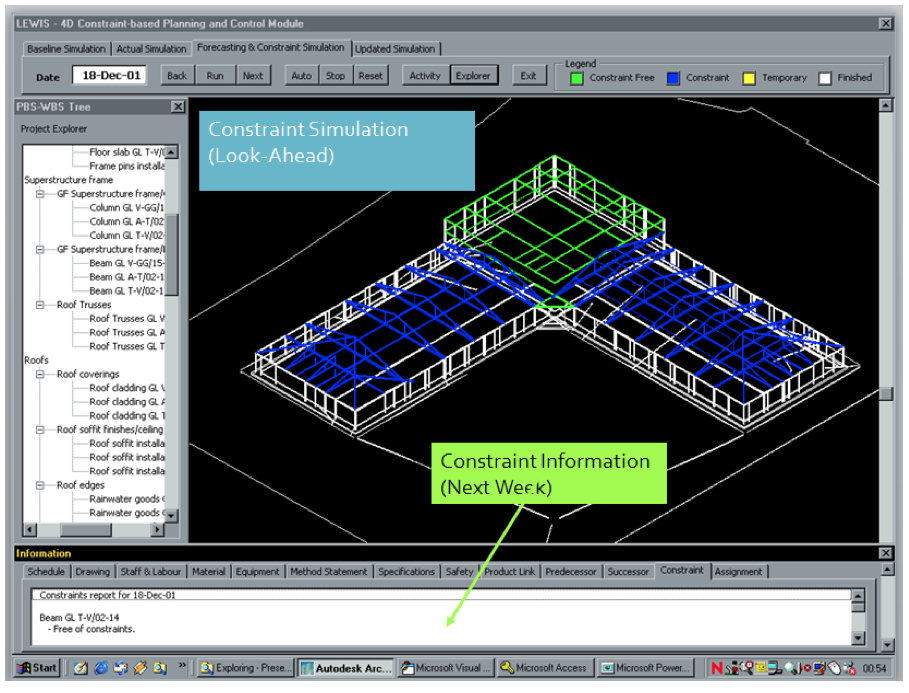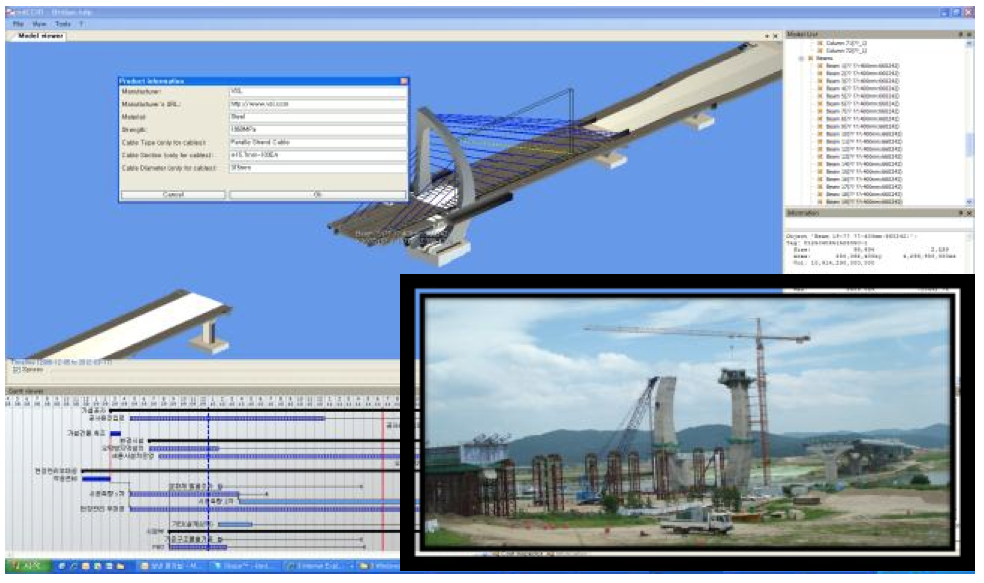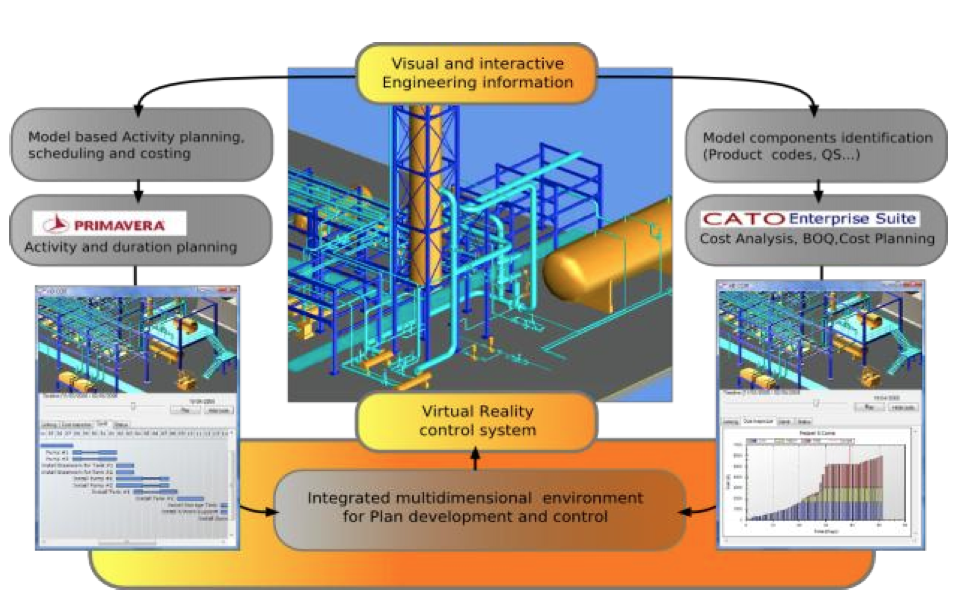Multi-constraint and multi-dimensional visual coordination approaches and tools and their applications in the Architectural, Engineering and Construction (AEC) industry through industrial collaborations
Submitting Institution
Teesside UniversityUnit of Assessment
General EngineeringSummary Impact Type
TechnologicalResearch Subject Area(s)
Mathematical Sciences: Applied Mathematics
Information and Computing Sciences: Artificial Intelligence and Image Processing
Engineering: Civil Engineering
Summary of the impact
Research at Teesside University has enhanced sustainability and
productivity in construction and related sectors. Between 1998 and 2008,
Professor Dawood's research team developed a range of advanced
multi-constraint and multi-dimensional visual construction planning and
coordination approaches and tools. The global commercial application of
this work in Architectural, Engineering and Construction (AEC)
organisations has generated a substantial economic impact. For five
indicative organisations used as examples in this case study, the impact
amounts to more than £1,500,000 in the form of increased
turnover, cash injection from technology funds and a spin out company.
Underpinning research
Three main pieces of research underpinned the impact:
1. Establishment of a Uniclass approach for the integration of product
and process data:
Between 1998 and 2004, Professor Dawood's team developed a new
Uniclass-based approach enabling the development of a number of software
tools: ProVis [1], a 4D visualisation tool; the VIRCON (VIRtual
CONstruction, EPSRC GR/N00890/01) database; and nDCCIR, which combined
these into a single system.
The adoption of Uniclass, a standard classification system for the
construction industry, allowed the integration of previously disparate
information systems providing, for the first time, a medium for
integrating visual and project planning, product breakdown (e.g. elements
of the building) and work breakdown (e.g. construction operations)
structures [1]. Product and process modelling technologies were
dynamically linked to the VIRCON database to provide 4D (3D plus time)
simulations [1] allowing rehearsal of the building's construction to
identify potential clashes and pinch points.
The technology developed was tested with the involvement of experts from
major construction companies in the UK and Europe (Skanska Construction,
Balfour Beatty, AMEC, Ferguson McIIveen LLP, MotEngil, and VSS Civil
Engineers) [2]. The work was carried out within a 4-year collaborative
research programme with University College London, the University of
Manchester (UMIST) and the University of Wolverhampton, as part of the
EPSRC-Innovative Manufacturing Initiative. The development of the nDCCIR
tool was undertaken through KTP collaboration with Atkins FG (Partnership
Number 6486).
2.Development of Multi Constraint Planning Methodology for agile and
efficient construction site management: Between 2002 and 2005 the
research team developed the approach above into a multi-constraint
planning and control methodology bringing together all aspects of the
supply chain, ensuring "constraint-free execution" of site assignments.
The availability of all necessary elements at the correct time and place
substantially reduces wastes and delays on construction sites [3, 4 and
5]. This multi-constraint approach enhances the conventional 3 levels of
construction planning (i.e. baseline planning, look-ahead planning,
commitment planning) by integrating them with information management
systems, 3D models and management theories of optimisation and "Last
Planner". This work led to the development of an IT tool, "LEWIS — Lean
Enterprise Web-Based Information System", shown above, representing a new
generation of planning and control systems overcoming the limitations of
traditional project management theory and existing information
technologies [3].

3. Development of Key Performance Indicators (KPIs) to enable the
benefits accruing from these new approaches to be quantified and measured
in live projects. Between 2005 and 2009 quantifiable KPIs for the
different performance measures (e.g. time, communication efficiency,
planning efficiency, cost, productivity, etc.) were developed and used by
Prof Dawood's research team to estimate the benefits achievable from the
deployment of the multi-constraint planning approaches and tools. The
measured KPIs included schedule performance (KPI: "schedule hit rate" — a
measure used to identify deviations between actual and planned progress)
and communication performance (KPI: time and cost saved in meetings) which
were measured in three £multi-million construction projects (£236 million)
over a period of 2 years. The results showed a hit rate increase to 72%, a
17% increase compared to the average industry schedule hit rate (55%) and
a 30% reduction in the time spent on meetings [6].
References to the research
The three papers that best indicate the quality of the underpinning
research are [1], [2] and [4]. The work presented in these papers are
outputs resulting from EPSRC research project funding (VIRCON EPSRC —
GR/N00890/01, £500k total with £120k to Teesside), led by Dawood.
[1] Dawood N., Sriprasert, E., Mallassi, Z. (2002) Development of
an integrated information resource base for 4D/VR construction processes
simulation. Automation in Construction, Vol. 12, pp. 123-131.
[2] Dawood N., Scott, D., Sriprasert, E., Mallassi, Z. (2005) The
virtual construction site (VIRCON) tool: an industrial evaluation. The
Journal of Information Technology in Construction, Vol. 10, pp.
43-54.
The industrial validation of the VIRCON tool presented in this work was
supported by an EPSRC Networking grant (£70k to Teesside) led by Dawood.
[3] Sriprasert, E. and Dawood, N. (2003) Multi-constraint
information management and visualisation for collaborative planning and
control in construction. The Journal of Information Technology in
Construction, Vol. 8, pp. 341-366.
[4] Dawood N., Sriprasert, E. (2006) Construction scheduling using
multi-constraints and genetic algorithms approach. Construction
Management and Economics, Vol 24 (1), pp. 19-30.
[5] Dawood N. and Mallassi, Z. (2006) Construction workspace
planning: Assignment and Analysis Utilizing 4D visualisation technologies.
Computer Aided Civil and Infrastructure Engineering, Vol 21 (7),
pp. 498-513.
[6] Dawood, N. and Sikka, S. (2009) Development of 4D based
performance indicators in construction industry. Engineering,
Construction and Architectural Management, Vol. 16 (5), pp. 438-458.
Details of the impact
The significance of the research findings, their impact on the AEC
industry and their extensive dissemination in peer reviewed journals,
international conferences and workshops have led to the research outcomes
being adopted by a number of major industrial players. The work featured
on the UK Prime Minister's Website and in the media [1]. For the
organisations involved, the tools developed from the work produced
economic benefits, arising from shortened project timeframes, more
reliable planning and end dates and consequent minimisation of associated
penalties and equipment hire costs; whilst the improved communication
efficiency enables improved productivity through reductions in design lead
time and wastages associated with design changes. The details of the
impact on five organisations is summarised below.
Dealim Industrial (South Korea), one of the largest
industrial conglomerates in South Korea, is using the nDCCIR package on
large infrastructure projects (e.g. the 2nd Geumgang Bridge-
see company's rehearsal of the bridge using nDCCIR, opposite). The company
has also adopted the KPI assessment tools developed by Prof. Dawood
enabling them to evaluate the impact. The company achieved a 95%
increase in schedule hit rate leading to decreased penalty
payments and equipment hire costs, 30% decrease in meeting time, and 5%
decrease in wastage related to reduced design changes and rework on
site, leading to a £178,500 increase in profit [2].

Ryder Architecture (UK) is a large architectural company.
Between 2009 and 2011 under a KTP project (Partnership Number 7304) the
company adopted the multi-constraint planning methodology to
facilitate improved coordination and management of their design processes.
As a result, Ryder achieved an increase of £249,500 in their
turnover, provided employment to 10 new staff members, and
established a new spin out company (BIM Academy) to provide new
consultancy services to the AEC industry [3].
Datum360 (UK) has been collaborating since 2010 with CCIR
researchers under a 3-year KTP project (Partnership Number 8668). During
this collaboration the software tools were further developed to
incorporate asset management (using class libraries) and commercialised
for application in the oil and gas industry. Through the use of this tool,
significant business was won with major oil & gas companies such as
BP, Tullow, GDF Suez E&P UK Ltd, Chevron and Woodside. This work
resulted in increased turnover for Datum360 of £448,000 over 2012 and
2013 [4]. Additionally in 2012, as a result of this development, the
company received £500,000 in investment from the Finance for
Business North East Technology Fund managed by IP Group [5]. The reach of
the work in the oil and gas sector has been extended by collaborative work
with the management consultancy, Faithful+Gould, to develop a bespoke
visual 5D CAD tool (3D + time + cost) for the oil and gas industry (see
opposite) [6].

Deepdale Solutions Ltd (UK) utilised the multi-constraint
and visualisation tools for planning and site simulation of a prestigious
development in Stratford in 2011/2012 (M8 Hotel). The project was required
to deliver a completed building envelope in time to meet the constrained
Olympic timetable with the added constraint that simultaneous access to
complete the building of the ground and first floor shopping centre was
required. These tools enabled Deepdale to identify an alternative
installation methodology with prefabricated (unitised) panels for the
entire envelope. This led to an estimated reduction of 30% in site
time compared to their previous norms, and a saving of
£140,000 in time-related activities (i.e. reduction in the number of
site operatives; reduction of manual handling and its associated health
and safety implications; elimination of the need for external means of
access/scaffolding as well as managing the complex constraints operating
at the site). In addition, use of the planning tools reduced the number of
interfaces between dissimilar materials/technologies allowing improved quality
control on site, and improved product quality arising from
the maximisation of finished assemblies under factory controlled
conditions [7].
A planning expert and Vice President of WEN Qatar W.L.L. gave the
following testimonial: "Managing the numerous constraints posed by us
internally and by our interface with other stakeholders is an extremely
complex and challenging issue. We have identified the theories and
concepts for multi-constraint management developed by CCIR researchers
and are currently using them on most of our projects. We found these
concepts extremely effective and they contributed to increase
the efficiency of our projects' delivery; decrease wastages
on site, and integrate our operation with our projects' partners. There
are among the first and fewest concepts in Project
Management to provide a holistic and integrated management of the
multiple constraints involved in projects" [8].
Sources to corroborate the impact
[1] NE
Business web site
[2] Testimonial from a Senior Manager from Dealim Industrial
[3] Final Report of the Knowledge Transfer Partnership
[4] Testimonial from the Managing Director of Datum360 Ltd.
[5] NE
Business web site
[6] Faithful
and Gould Website
[7] Testimonial from the MD of Deepdale solutions Ltd.
[8] Factual statement from WEN Qatar W.L.L.